“Apicultural Utopia: Architecture for bees”
Elizabeth Presa
18 Oct → 16 Nov 2013
Gallery 3

Because of the structure of its wax cells, the bee appears to surpass the greater skill of the architect. But what distinguishes the worst of architects from the most expert bee is the fact that the bee has constructed the cell in his head before he builds it in the hive. Karl Marx
There are happy moments for the masses, when civic pride overcomes them and lifts them firmly towards a higher level. Maurice Maeterlinck, The Life of Bees
Historically, beehives have provided ideologically complex metaphors of utopian systems of labour, design, dwelling and spirituality. The 17th century Spanish mystic, Teresa of Avila connected prayer to beehives and honey in her writings; Bingham Young, the polygamous leader of the Mormons installed himself like a queen bee in a house known as the Beehive in Salt Lake City; while Rudolph Steiner saw bee hives as mystical models of social cohesion and spiritual transformation. Modernist architects and artists including Gaudi, Mies van der Rohe, Le Corbusier, Frank Lloyd Wright and Joseph Beuys owe a long debt to apian structures and materials. Today in densely populated urban sites such as the Ginza district in Tokyo, rooftop beehives are a source of communal interaction and ecological activism for local office workers.
This project inverts this debt and makes architectural structures to provide small utopias for bees.
Elizabeth Presa often works with philosophers and with animals including silkworms, snails, jellyfish and bees in her installation work. She is interested in materializing metaphors of textuality, reading and writing.